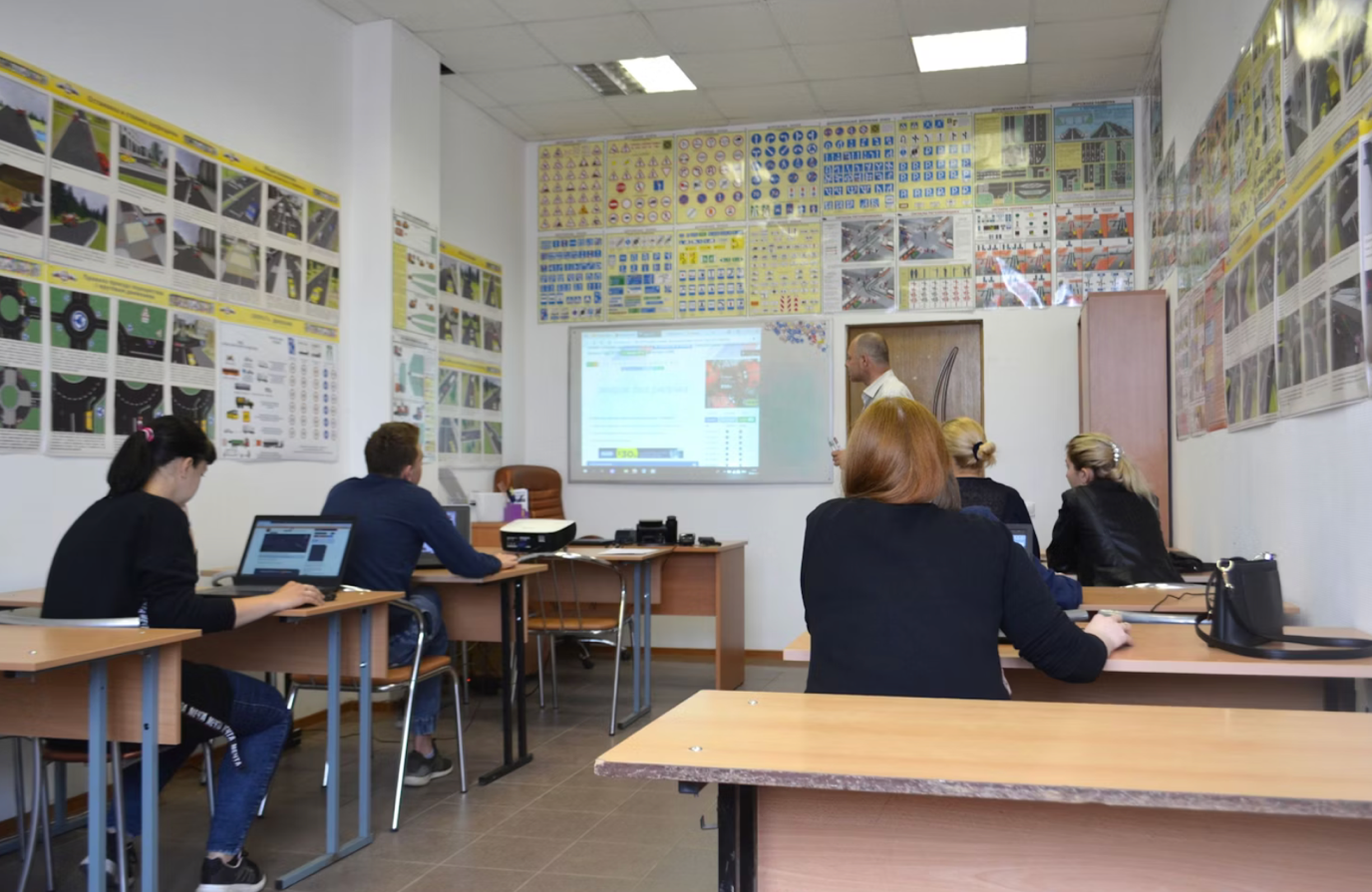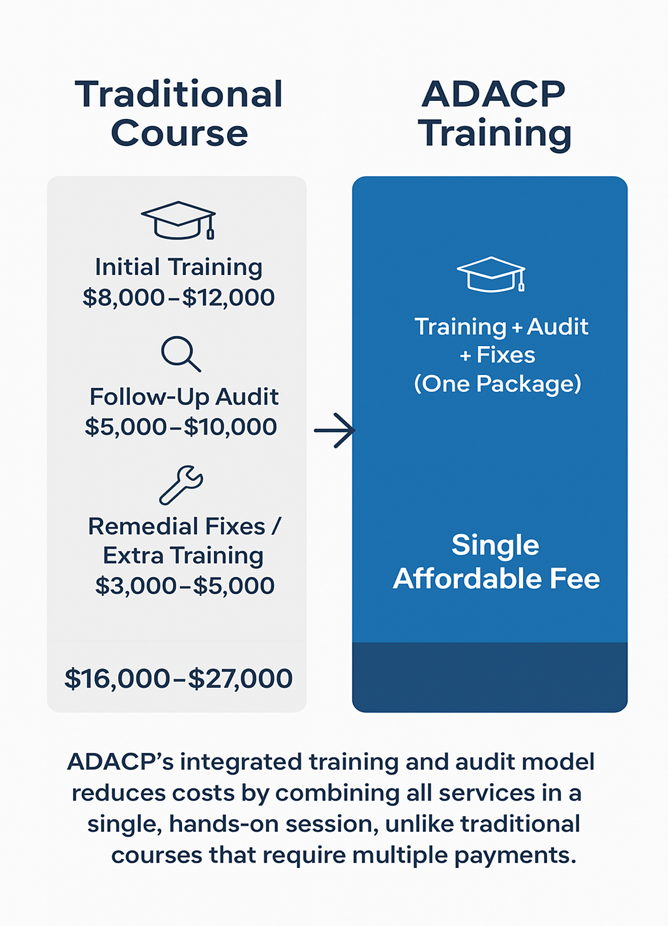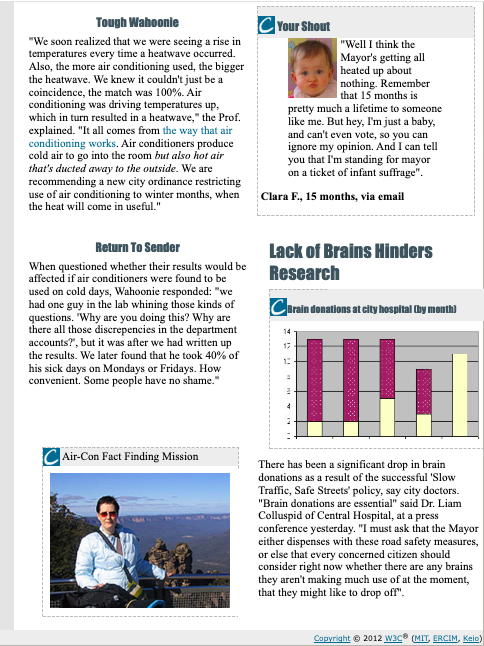
What Most Web Accessibility Courses Miss? How ADACP Fills the Gap
Imagine your team just completed an online accessibility course. Everyone passed the quizzes, but when they go back to edit real PDF documents or update their website, the same accessibility issues keep popping up. Hours of training feel wasted and your organization ends up paying again for audits and remedial fixes.
It happens because most web accessibility courses don’t prepare staff for the real-world content they manage every day.
ADACP fills this gap with hands-on, instructor-led digital accessibility training. We combine live audits and teach teams while fixing accessibility issues. Real time identification and solutions save both time and money for organizations.
What Most Accessibility Courses Miss
Most accessibility training programs share the same flaws:
Lack of Real-World Context
Pre-recorded courses often teach rules like “Add alt text” or “Ensure keyboard navigation,” but rarely show how these rules apply to the team’s actual PDFs or websites. Learners struggle to implement what they have learned without context.
Delayed Problem-Solving
Teams learn theory but don’t fix existing accessibility gaps. Weeks or months later, organizations must hire auditors to review content again which incurs extra costs.

Single Event Training
Real compliance requires continuous application and updates with website refresh. A course completed once does not ensure lasting accessibility.
No Immediate Feedback
Learners often make mistakes while applying concepts. Pre-recorded modules can’t provide real-time feedback. Your team is left with knowledge gaps that are unaddressed.
High Long-Term Costs
Companies often pay multiple times: first for training, then for audits and then for remedial fixes. This approach is more expensive than investing in a comprehensive, integrated solution (Image 1).
How ADACP WCAG training fills the gap
ADACP takes a results-oriented approach. Our training model for WCAG and 508 training integrates three critical components:
1. Hands-On, Instructor-Led Training
ADACP’s sessions are live and interactive. Participants work on real accessibility challenges, guided by expert instructors.
Benefits:
- Mistakes are corrected immediately
- Participants can ask questions specific to their workflow
- Skills are applied instantly, improving retention
2. Simultaneous Audit and Training
We audit your website or documents while training your team. This approach allows organizations to identify issues in real-time.
Your team can apply fixes immediately and reinforce lessons with practical examples.
A mid-sized company with over 300 pages of web content selected ADACP for Section 508 Compliance Training. Within the first two-day session:
- 120 pages were audited
- 75% of critical accessibility issues were resolved
- Staff learned how to fix the remaining issues themselves
3. Cost and Time Savings
Because training and audit happen simultaneously, organizations avoid duplicate costs. Instead of paying for a course and then a separate audit, ADACP combines services.
An average organization using pre-recorded courses may spend $8,000–$12,000 on training plus another $5,000–$10,000 for a follow-up audit.
ADACP’s integrated program often reduces total cost by 30–40%, while delivering faster, better results. Refer to this blog [Why Hands-On Accessibility Training Works Better Than Pre-Recorded Courses] for a detailed comparison between hands-on training and self-paced courses.
How Hands-On training beats Self-Paced Courses
Hands-on learning directly impacts compliance and retention.
Immediate Skill Application
ADACP participants work on actual website content, PDFs, or apps, ensuring knowledge isn’t theoretical. The moment they encounter an accessibility problem, instructors guide them through a fix.
Reinforced Learning Through Practice
Research shows that adults retain up to 75% of knowledge when they actively practice new skills, versus 30% for passive learning. By the end of ADACP sessions, teams become confident and know what to do. If you want to empower your teams with skills that stick then schedule a free consultation for digital accessibility training with us.
Real-Time Problem Solving
Questions that arise in context get answered immediately. Teams leave with a clear understanding of:
- How to write descriptive alt text
- How to structure accessible tables
- How to design forms compliant with WCAG 2.2 and Section 508

Source: https://www.w3.org/WAI/demos/bad/before/news.html
Key accessibility issues in the above annotated example
Missing Alt Text for Images:
- Issue: Images lack descriptive alternative text. It is difficult for screen reader users to understand the content.
- Solution: Provide meaningful alt text for all informative images.
Poor Color Contrast:
- Issue: Text and background color combinations do not meet the minimum contrast ratio, affecting readability.
- Solution: Ensure sufficient contrast between text and background colors.
Improper Heading Structure:
- Issue: Headings are used inconsistently. It will hinder content navigation for screen reader users.
- Solution: Use proper heading tags (<h1>, <h2>, etc.) to structure content hierarchically.
Missing Keyboard Navigation:
- Issue: Interactive elements are not accessible via keyboard. This type of content excludes users with motor disabilities.
- Solution: Ensure all interactive elements are accessible using keyboard navigation.
What is the long-term ROI of hands-on digital accessibility training?
ADACP’s hands-on training reduces legal risks by proactively addressing accessibility issues. Teams become more efficient while fixing real problems and avoiding repeated audits or retraining. Accessible content improves user experience. Hands-on training ensures compliance remains scalable as content grows or changes.
How did one team achieve complete Section 508 Compliance?
A mid-sized marketing firm struggled with accessibility. They had tried a popular self-paced course but still faced missing alt text, poor form accessibility and inconsistent headings and labels.
After partnering with ADACP:
- A two-day instructor-led session resolved 80% of issues immediately
- Team gained skills to fix remaining problems without additional support
- An estimated 40% cost savings compared to separate course + audit
- Users reported higher satisfaction with accessible forms and content
Table1: ROI comparison table of ADACP training Vs. traditional self-paced courses
How long does it take to see results from ADACP training?
Most teams see measurable improvements within the two-day training session. Immediate fixes are implemented during the workshop, and remaining issues are resolved within days using the skills gained.
Why Organizations Keep Returning to ADACP
Flexibility – Sessions can be modular to fit busy schedules.
Expertise – Trainers are experienced in WCAG 2.2, Section 508, and real-world content remediation.
Adaptability – As accessibility laws and standards evolve, ADACP updates training materials, ensuring ongoing relevance.
Team Empowerment – Participants leave confident in creating accessible content without depending on external auditors repeatedly.
Who benefits most from hands-on instructor led web accessibility training?
This training model is suitable for marketing teams, web developers, content creators and compliance managers. Team members who need practical skills and immediate results benefit the most.
Conclusion
Pre-recorded courses are convenient but often ineffective in practice. ADACP’s integrated, instructor-led approach bridges the gap between learning and doing. It combines training and audit to deliver long-term results.
Organizations can save money and improve compliance in a single, efficient program.
What are you waiting for? Contact ADACP today to schedule a free consultation for the best web accessibility training courses.
Imagine your team just completed an online accessibility course. Everyone passed the quizzes, but when they go back to edit real PDF documents or update their website, the same accessibility issues keep popping up. Hours of training feel wasted and your organization ends up paying again for audits and remedial fixes.
It happens because most web accessibility courses don’t prepare staff for the real-world content they manage every day.
ADACP fills this gap with hands-on, instructor-led digital accessibility training. We combine live audits and teach teams while fixing accessibility issues. Real time identification and solutions save both time and money for organizations.
What Most Accessibility Courses Miss
Most accessibility training programs share the same flaws:
Lack of Real-World Context
Pre-recorded courses often teach rules like “Add alt text” or “Ensure keyboard navigation,” but rarely show how these rules apply to the team’s actual PDFs or websites. Learners struggle to implement what they have learned without context.
Delayed Problem-Solving
Teams learn theory but don’t fix existing accessibility gaps. Weeks or months later, organizations must hire auditors to review content again which incurs extra costs.

Single Event Training
Real compliance requires continuous application and updates with website refresh. A course completed once does not ensure lasting accessibility.
No Immediate Feedback
Learners often make mistakes while applying concepts. Pre-recorded modules can’t provide real-time feedback. Your team is left with knowledge gaps that are unaddressed.
High Long-Term Costs
Companies often pay multiple times: first for training, then for audits and then for remedial fixes. This approach is more expensive than investing in a comprehensive, integrated solution (Image 1).
How ADACP WCAG training fills the gap
ADACP takes a results-oriented approach. Our training model for WCAG and 508 training integrates three critical components:
1. Hands-On, Instructor-Led Training
ADACP’s sessions are live and interactive. Participants work on real accessibility challenges, guided by expert instructors.
Benefits:
- Mistakes are corrected immediately
- Participants can ask questions specific to their workflow
- Skills are applied instantly, improving retention
2. Simultaneous Audit and Training
We audit your website or documents while training your team. This approach allows organizations to identify issues in real-time.
Your team can apply fixes immediately and reinforce lessons with practical examples.
A mid-sized company with over 300 pages of web content selected ADACP for Section 508 Compliance Training. Within the first two-day session:
- 120 pages were audited
- 75% of critical accessibility issues were resolved
- Staff learned how to fix the remaining issues themselves
3. Cost and Time Savings
Because training and audit happen simultaneously, organizations avoid duplicate costs. Instead of paying for a course and then a separate audit, ADACP combines services.
An average organization using pre-recorded courses may spend $8,000–$12,000 on training plus another $5,000–$10,000 for a follow-up audit.
ADACP’s integrated program often reduces total cost by 30–40%, while delivering faster, better results. Refer to this blog [Why Hands-On Accessibility Training Works Better Than Pre-Recorded Courses] for a detailed comparison between hands-on training and self-paced courses.
How Hands-On training beats Self-Paced Courses
Hands-on learning directly impacts compliance and retention.
Immediate Skill Application
ADACP participants work on actual website content, PDFs, or apps, ensuring knowledge isn’t theoretical. The moment they encounter an accessibility problem, instructors guide them through a fix.
Reinforced Learning Through Practice
Research shows that adults retain up to 75% of knowledge when they actively practice new skills, versus 30% for passive learning. By the end of ADACP sessions, teams become confident and know what to do. If you want to empower your teams with skills that stick then schedule a free consultation for digital accessibility training with us.
Real-Time Problem Solving
Questions that arise in context get answered immediately. Teams leave with a clear understanding of:
- How to write descriptive alt text
- How to structure accessible tables
- How to design forms compliant with WCAG 2.2 and Section 508

Source: https://www.w3.org/WAI/demos/bad/before/news.html
Key accessibility issues in the above annotated example
Missing Alt Text for Images:
- Issue: Images lack descriptive alternative text. It is difficult for screen reader users to understand the content.
- Solution: Provide meaningful alt text for all informative images.
Poor Color Contrast:
- Issue: Text and background color combinations do not meet the minimum contrast ratio, affecting readability.
- Solution: Ensure sufficient contrast between text and background colors.
Improper Heading Structure:
- Issue: Headings are used inconsistently. It will hinder content navigation for screen reader users.
- Solution: Use proper heading tags (<h1>, <h2>, etc.) to structure content hierarchically.
Missing Keyboard Navigation:
- Issue: Interactive elements are not accessible via keyboard. This type of content excludes users with motor disabilities.
- Solution: Ensure all interactive elements are accessible using keyboard navigation.
What is the long-term ROI of hands-on digital accessibility training?
ADACP’s hands-on training reduces legal risks by proactively addressing accessibility issues. Teams become more efficient while fixing real problems and avoiding repeated audits or retraining. Accessible content improves user experience. Hands-on training ensures compliance remains scalable as content grows or changes.
How did one team achieve complete Section 508 Compliance?
A mid-sized marketing firm struggled with accessibility. They had tried a popular self-paced course but still faced missing alt text, poor form accessibility and inconsistent headings and labels.
After partnering with ADACP:
- A two-day instructor-led session resolved 80% of issues immediately
- Team gained skills to fix remaining problems without additional support
- An estimated 40% cost savings compared to separate course + audit
- Users reported higher satisfaction with accessible forms and content
Table1: ROI comparison table of ADACP training Vs. traditional self-paced courses
How long does it take to see results from ADACP training?
Most teams see measurable improvements within the two-day training session. Immediate fixes are implemented during the workshop, and remaining issues are resolved within days using the skills gained.
Why Organizations Keep Returning to ADACP
Flexibility – Sessions can be modular to fit busy schedules.
Expertise – Trainers are experienced in WCAG 2.2, Section 508, and real-world content remediation.
Adaptability – As accessibility laws and standards evolve, ADACP updates training materials, ensuring ongoing relevance.
Team Empowerment – Participants leave confident in creating accessible content without depending on external auditors repeatedly.
Who benefits most from hands-on instructor led web accessibility training?
This training model is suitable for marketing teams, web developers, content creators and compliance managers. Team members who need practical skills and immediate results benefit the most.
Conclusion
Pre-recorded courses are convenient but often ineffective in practice. ADACP’s integrated, instructor-led approach bridges the gap between learning and doing. It combines training and audit to deliver long-term results.
Organizations can save money and improve compliance in a single, efficient program.
What are you waiting for? Contact ADACP today to schedule a free consultation for the best web accessibility training courses.

We will contact you shortly.





.svg)
.svg)
.svg)
.webp)























.svg)

.svg)